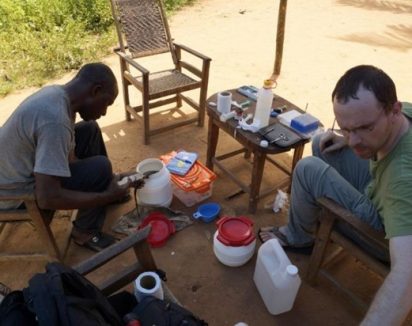
Assessing the diversity of the Central (and West) African herpetofauna – improving herpetological collections & knowledge and establishing a new research network
Project details
2011, 2012, 2013, 2014 and 2015
Benin and DR Congo
Animalia – Chordata – Amphibia & Reptilia
Royal Belgian Institute of Natural Sciences
Due to the lack of concerted and intensive surveys in the past and infrastructural and logistic challenges in the present, the herpetofauna of Central Africa (particularly that of the Democratic Republic of the Congo), and partly that of West Africa, is poorly known. This leaves a large gap in our understanding of Afrotropical amphibian and reptile diversity and hence an enormous potential for exploration; species diversity is most likely severely underestimated. Moreover, the DRC lacks well-trained specialists in herpetology, both in academic research and nature conservation.
With the current proposal a Congolese herpetologist will be trained in contemporary field and laboratory methods, taxonomic practice and in modern collection building and management strategies. To achieve these aims, on-site field trainings in different localities in the DRC are planned, followed by an intensive laboratory training at the Royal Belgian Institute of Natural Sciences in Belgium. The following localities have been selected:
Important short-term outcomes of the project will be herpetofaunistic checklists of the surveyed sites as well as scientific publications. In the long(er) run, the trained Congolese herpetologist will act as a multiplicator in his home country, by establishing a team, by the recruitment and education of new specialists and allocation of research and curatorial capacities dedicated to herpetological studies. His institutional links within the country as well as a number of international collaborations will ensure a successful realization of the project which will be serving as a core for further herpetological research in the DRC.
In 2013, in addition to the achievements from the 2011 & 2012 projects, three main objectives are to be realized:
In 2014, the focus of the project is on establishing new links and collaborations with young researchers at the University of Kisangani. Offering them a series of trainings and capacity building may help to establish a long-term perspective of herpetological research in the DRC. Since 2013, a new collaboration has started with the University of Kisangani and the ‘Centre de Surveillance de la Biodiversité’ (CSB) through Erik Verheyen (RBINS and University of Antwerp). During a field survey in November 2013, two persons – Jeannot Akuboy Bodongola and Gabriel Badjedjea Babangenge – were identified as prosperous candidates for a herpetological training. Both of them are very early-stage researchers (i.e., shortly before master degree), but clearly committed to perform herpetological research. Hence, a career at the CSB seems to be a great opportunity for both of them. Nevertheless, a series of training is needed for both persons to improve their theoretical and practical knowledge. Therefore, a training on site and a field expedition in 2014 that could involve both Jeannot Akuboy Bodongola and Gabriel Badjedjea Babangenge is proposed. Their current herpetological interest is complementary (snakes versus frogs, respectively), but they both need to learn some basic techniques and develop their skills. Associated to this, efforts will also be made to improve hard capacities, e.g. by purchasing equipment needed for scientific collection and for depositing voucher specimens and corresponding tissue samples.
Until 2014, activities focus on intensive field work at different sites in the DRC with the ambitious aim to create a reference collection of amphibians and reptiles, and on training a few key persons in the country. In addition to the expeditions, network building is done. In 2015, this network is to be expanded by targeting a circle of prospective students and the project will be extended to another (West African) country, Benin. With on-site field trainings, 2-day intensive workshops and other capacity building measures, the RBINS researchers will help to establish a basis for long-term, independent research. Consequently, they would like to inspire and support the creation of a South-South network in herpetological research. Facilitating and supporting such South-South collaborations and networking will make an important step in implementing biodiversity assessments and formulating advises to nature conservation in Africa – beyond country borders.